
Minuartia is a genus of flowering plants commonly known as sandworts in the family Caryophyllaceae.

Cerastium glomeratum is a species of flowering plant in the family Caryophyllaceae known by the common names sticky mouse-ear chickweed and clammy chickweed. It is probably native to Eurasia but it is known on most continents as an introduced species. It grows in many types of habitat. The blooming period is February, March, April, and May.
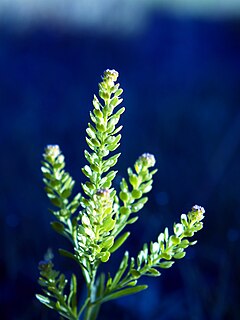
Lepidium densiflorum is a species of flowering plant in the mustard family known by the common names common pepperweed and prairie peppergrass.

Minuartia groenlandica, the Greenland stitchwort or mountain stitchwort, Appalachian stitchwort, mountain sandwort, smooth mountain sandwort, and smooth sandwort is a rare perennial which grows low to the ground in clumps linked together at the bottom. It has three to five pairs of leaves in a linear opposite pattern along the length of the slender stem. The main stem breaks into one to thirty cymes which each flower separately. The flowers are white and arise five to ten centimeters above the thick foliage. The white flower petals are six to ten millimeters long. The petals are, in turn, surrounded by five green sepals.
Minuartia californica, commonly known as California sandwort, is a species of flowering plant in the family Caryophyllaceae.
Minuartia decumbens is a rare species of flowering plant in the family Caryophyllaceae known by the common names The Lassics sandwort and Lassicus stitchwort.
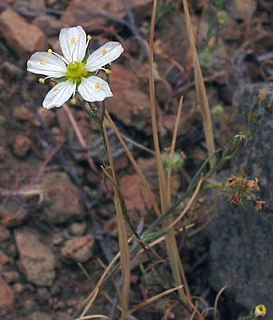
Minuartia douglasii is a species of flowering plant in the family Caryophyllaceae known by the common name Douglas' stitchwort.
Minuartia howellii is an uncommon species of flowering plant in the family Caryophyllaceae known by the common names Howell's stitchwort and Howell's sandwort.

Minuartia nuttallii is a species of flowering plant in the family Caryophyllaceae known by the common names Nuttall's sandwort and brittle sandwort.
Minuartia rosei is an uncommon species of flowering plant in the family Caryophyllaceae known by the common names peanut sandwort and peanut stitchwort.

Minuartia rubella is a species of flowering plant in the family Caryophyllaceae known by several common names, including beautiful sandwort, mountain sandwort, Arctic sandwort, and boreal stitchwort. It has a circumboreal distribution, occurring throughout the northernmost Northern Hemisphere from the Arctic Circle on the Arctic tundra into the alpine climates of mountainous areas in temperate Eurasia and North America. It grows in rocky, moist, often barren habitat, including gravelly, sparsely vegetated slopes with little organic matter. It is a calciphile, growing in calcareous substrates such as soils rich in decomposed limestone.

Minuartia stolonifera is a rare species of flowering plant in the pink family known by the common names Scott Mountain sandwort and stolon sandwort.
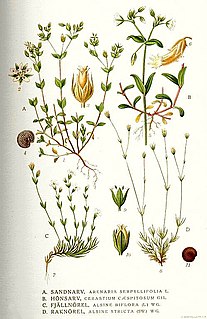
Minuartia stricta is a species of flowering plant in the family Caryophyllaceae known by the common names bog stitchwort, Teesdale sandwort and rock sandwort. It has a circumboreal distribution, occurring throughout much of the northernmost Northern Hemisphere from the lower Arctic into the alpine climates of mountainous areas in temperate Eurasia and North America. It grows in several types of habitat, including meadows, marshes, heath, beaches and bars, and arctic and alpine tundra.
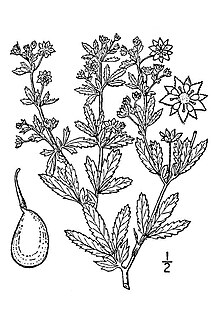
Potentilla rivalis is a species of cinquefoil known by the common names brook cinquefoil and river cinquefoil. It is native to much of North America, including the southern half of Canada and the western and central United States. It grows in moist habitat, sometimes in disturbed areas. It is an annual or biennial herb producing upright stems up to half a meter tall from a taproot. The hairy leaves are divided into three to five leaflets which are lance-shaped to oval and lined with teeth. The inflorescence is a cluster of several flowers with tiny yellow petals no more than 2 millimeters long on a calyx of pointed sepals and bractlets which are slightly longer.
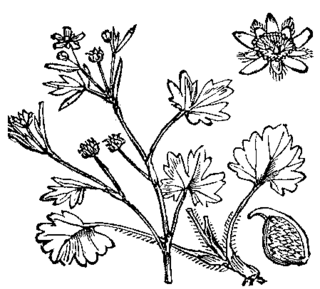
Ranunculus parviflorus is a species of buttercup known by the common name smallflower buttercup. It is native to Europe, but it is known on other areas of the world as an introduced species and sometimes a roadside weed, for example, in parts of Australia and the United States.
Sibara virginica is a species of flowering plant in the family Brassicaceae known by the common name Virginia winged rockcress. It is native to North America, where it can be found throughout the southeastern quadrant of the United States and in California and Baja California in the west. It grows in many types of habitat, including disturbed areas. It is an annual or biennial herb producing a basal rosette of leaves with comblike blades so deeply divided into many lobes that they may appear to have leaflets. It bolts one or more erect stems up to 30 centimeters tall. The flowers each have four spoon-shaped white petals a few millimeters long and purplish sepals. The fruit is a flattened, elongated silique up to 2.5 centimeters long containing tiny seeds.

Stellaria nitens is a species of flowering plant in the family Caryophyllaceae known by the common names shiny chickweed and shining starwort. It is native to western North America, including British Columbia, Alberta, and the western United States, its distribution extending into Mexico at least as far as Baja California. It grows in many types of habitat, in dry and moist areas, and sometimes in disturbed places. It is an annual herb producing a slender, upright, four-angled stem from a thin taproot, reaching up to about 25 centimeters in height. Most of the leaves are located low on the stem, each measuring up to 1.5 centimeters long, with smaller, narrower leaves occurring above. The leaves are hairless except for some rough hairs along the margins, and the blades have shiny surfaces. The inflorescence bears a few flowers on short pedicels. The flower has five pointed sepals each a few millimeters long. There are sometimes five tiny white petals as well, though these are often absent.
Stellaria umbellata is a species of flowering plant in the family Caryophyllaceae known by the common names umbrella starwort and umbellate starwort. It is native to western North America from Alaska and northwestern Canada to the southwestern United States, as well as parts of Asia, including Siberia. It grows in subalpine and alpine climates in mountain forests and riverbanks. It is a rhizomatous perennial herb producing a slender prostrate stem up to about 20 centimeters long, sometimes forming clumps or mats. The stem is lined with pairs of oval leaves each up to about 2 centimeters long. The inflorescence is an umbel-shaped array of several flowers each on an arching or erect pedicels. The flower has five pointed green sepals each no more than 3 millimeters long. There are occasionally tiny white petals within the calyx of sepals, but these are generally absent.
Minuartia cismontana is a species of flowering plant in the family Caryophyllaceae known by the common name cismontane minuartia.

Pterostylis pusilla, commonly known as the tiny rustyhood is a plant in the orchid family Orchidaceae and is endemic to southern Australia. It has a rosette of leaves and up to nine relatively small green and reddish-brown flowers with translucent white "windows" and a dark brown, insect-like labellum.












